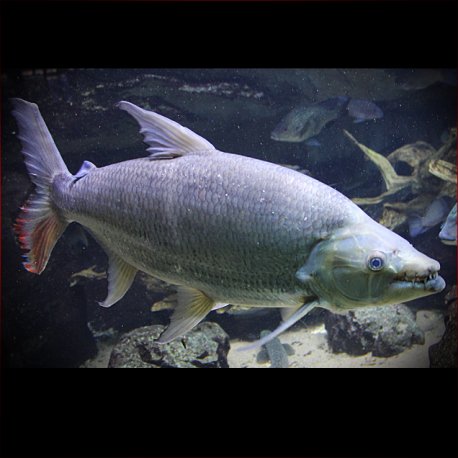More info
Datasheet
| Minimum Tank Size | 15000 litres / 3962.58 US gallons |
| Maximum Size | 210.0cm / 82.68inches |
| Temperature | 24°C / 75.20°F - 28°C / 82.40°F |
| Hardness | 10-25ºdH |
| pH | 6.5-7.5 |
General Description
The Giant Tigerfish, scientifically known as Hydrocynus Goliath, is a voracious piscivore with a streamlined and muscular body designed for hunting. This species boasts a set of dagger-shaped, interlocking teeth that enable it to tear through prey effortlessly. Weighing over 100 pounds, it is infamous as a game fish, though highly unsuitable for aquarium life due to its predatory nature and potential danger to handlers.
Aquarium Setup
The recommended aquarium setup for the Giant Tigerfish includes a bare environment with a sandy base. Water quality must be excellent and well-oxygenated to support its active swimming habits. A tank size of at least 15000 liters is crucial, considering the fish's adult size potential of up to 210.0cm. Detailed water conditions encompass a pH range of 6.5-7.5, a temperature range of 24-28°C, and a water hardness of 10-25°dH.
Behaviour
Typically solitary in captivity, the Giant Tigerfish should not be housed with smaller tankmates as they may become prey. Juvenile fish may exhibit schooling behavior, though caution is advised when keeping them with other species. Reports show compatibility with larger tankmates like Loricariids and cichlids, primarily under specific size and age conditions.
Feeding and Diet
Often classified as a piscivore, the Giant Tigerfish's diet primarily consists of live fish in the wild. Contrary to popular belief, they can be weaned onto dead foods like whitebait with relative ease. This adaptability in diet can aid in captive care, although live prey may still be a preferred option for nutritional balance.
Reproduction & Dimorphism
Reproduction of the Giant Tigerfish has not been documented in aquarium settings, adding mystery to its sexual dimorphism. The distinct differences, if any, between male and female specimens remain unknown, highlighting the need for further research into their breeding habits.
Habitat and Distribution
Native to Tanzania and the Democratic Republic of Congo, this species thrives in large rivers and lakes such as Tanganyika. Their natural habitat reflects the need for expansive water bodies with ample space for swimming and hunting, further emphasizing their unsuitability for confined aquarium environments.

